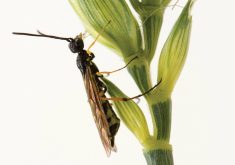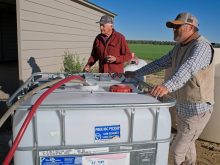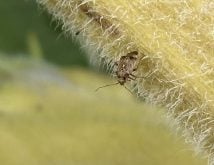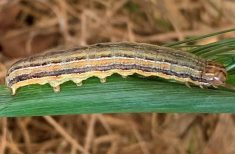Throughout the growing season growers are tasked with the need to tell the difference between many “good” and “bad” things in the field. Sometimes it is hard to quickly tell the difference. Knowing the difference between things in the field is critical to determine if, when, and how to treat.
Take for example the red turnip beetle and Collops beetle. Both beetles have red and black stripes and look quite tiny: each being no more than half an inch long. But with closer inspection, there are differences.
Read Also

Cancer agency reclassifies another herbicide ‘probably carcinogenic’
The WHO’s cancer research agency has now put atrazine, a herbicide well known to corn growers, in the same potential-hazard category where the agency put glyphosate.
The bad
The red turnip beetle Entomoscelis Americana is a pest. This beetle has three black stripes down its back, has a hard shell, and its head and thorax has both red & black patches. This beetle is the largest of the two, and is between seven and 10 mm long.
These “bad” bugs like cruciferous plants such as: canola, mustard, radish and turnips. The adults do the most damage, with the worst of it occurring in June. The red turnip beetle feeds on many parts of the plant including leaves, flowers, stems and seedpods. The fields first affected are: fields having heavy loads of weeds from cruciferous family (such as volunteer canola, flixweed and mustard), fields not having had a break between planting canola or other crucifers, and fields adjacent to those that had a cruciferous crop the year before. Damage to seedlings is usually most noticeable starting at the edges and moving inwards.
Currently there are no established economic thresholds for this pest, nor are there any registered herbicides for the red turnip beetle. According to John Gavloski, an entomologist with Manitoba Agriculture, “Economic damage can happen, but it is not common.” But that doesn’t mean that these bugs will never get to damaging levels: in 2017, reports of severe damage due to the red turnip beetle in canola was reported in certain areas of Alberta.
The good
The Collops vittatus beetle pictured below is a “good” beetle: it is a predator of other soft bodies insects or early stages of insects: such as lygus nymphs, aphids, flea beetles, caterpillars, whiteflies, and some insect eggs. We want their free labour. These good beetles are approximately four to six mm in length, have two black stripes down its back (or sometimes blotches) and a soft shell is soft. It is sometimes aptly referred to as “two lined collops.” Some sources may refer to this beetle as having a dark blue colour, but in this picture it looks black. The thorax, or middle part of this insect is mainly red, with one to two black spots.

The options
There are many great resources at our fingertips to help us diagnose issues in the field. For a quick check, there are often apps to check, and you can post questions on Twitter. For definite confirmation, we are also very fortunate to be able to reach out to experts in the field. In this case, John Gavloski provided valuable and efficient input and identification of the beetle found in a southwest Manitoba field. A producer had initially identified it as the bad bug — red turnip beetle.
Collops beetles have been misidentified as the red turnip beetle by agronomists and at least one producer, likely more. This could be a concern if it results in a producer spraying an insecticide unnecessarily. We don’t want to disrupt the balance of good beetles, use chemical if not needed or waste money unnecessarily. Using these beneficial insects is part of integrated pest management.
















